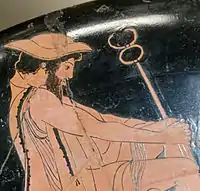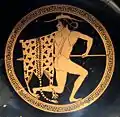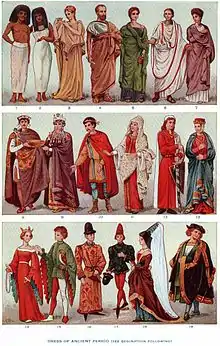A petasos (Greek: πέτασος) or petasus (Latin) is a broad brimmed hat of Thessalian origin worn by ancient Greeks, Thracians and Etruscans,[1] often in combination with the chlamys cape. It was made of wool felt, leather, straw or animal skin. Women's versions had a high crown while those for men featured a lower crown.[2] It was worn primarily by farmers, travellers and hunters, and was considered characteristic of rural people. As a winged hat, it became the symbol of Hermes, the Greek mythological messenger god.[3]
Along with the pileus, the petasos was the most common hat worn in Ancient Greece.[4] Its wide brim protected the wearer from the sun and rain while a lengthy strap allowed wearers to secure it under the chin. Its popularity later extended to the Etruscans, the Byzantine Empire and the Roman Empire, in slightly modified forms.[5]
A type of metal helmet worn by Athenian cavalry was made in the shape of a petasos. Some examples have holes around the outer edge of the brim, presumably so a fabric cover could be attached. These are known from reliefs and vase paintings, with at least one archaeological example found in an Athenian tomb.[6]
Gallery
 Hermes wearing a petasos and bearing a caduceus
Hermes wearing a petasos and bearing a caduceus Views of a petasos
Views of a petasos Petasos-wearing youth with spear and leopardskin
Petasos-wearing youth with spear and leopardskin Young warrior with a cloak and petasos dangling over the back
Young warrior with a cloak and petasos dangling over the back._Struck_circa_460-450_BC._Young_male_head_right%252C_wearing_petasos.jpg.webp) Coin of Alexander I, struck circa 460-450 BC. Young male head right, wearing a petasos.
Coin of Alexander I, struck circa 460-450 BC. Young male head right, wearing a petasos.._Head_of_Hermes_right%252C_wearing_winged_petasos_One-handled_lekythos.jpg.webp)
See also
References
- ↑ Bonfante, Larissa (2003-10-31). Etruscan Dress. JHU Press. ISBN 9780801874130.
- ↑ Britannica, The Editors of Encyclopaedia. "petasos". Encyclopedia Britannica, 26 Jul. 2010, https://www.britannica.com/topic/petasos . Accessed 29 November 2021.
- ↑ Sacks, David. "clothing, ancient Greek." Encyclopedia of the Ancient Greek World, David Sacks, Facts On File, 3rd edition, 2015. Credo Reference. Accessed 29 Nov. 2021.
- ↑ "Greek Headwear." Fashion, Costume, and Culture: Clothing, Headwear, Body Decorations, and Footwear Through the Ages, edited by Sara Pendergast, et al., 2nd ed., vol. 1: The Ancient World, UXL, 2013, pp. 127-134. Gale In Context: World History. Accessed 28 Nov. 2021.
- ↑ "Headwear of the Byzantine Empire." Fashion, Costume, and Culture: Clothing, Headwear, Body Decorations, and Footwear Through the Ages, edited by Sara Pendergast, et al., 2nd ed., vol. 2: Early Cultures Across the Globe, UXL, 2013, pp. 257-259. Gale In Context: World History. Accessed 28 Nov. 2021.
- ↑ Nicholas Sekunda, The Ancient Greeks (Osprey Publishing, 1986, 2005), p. 19.

